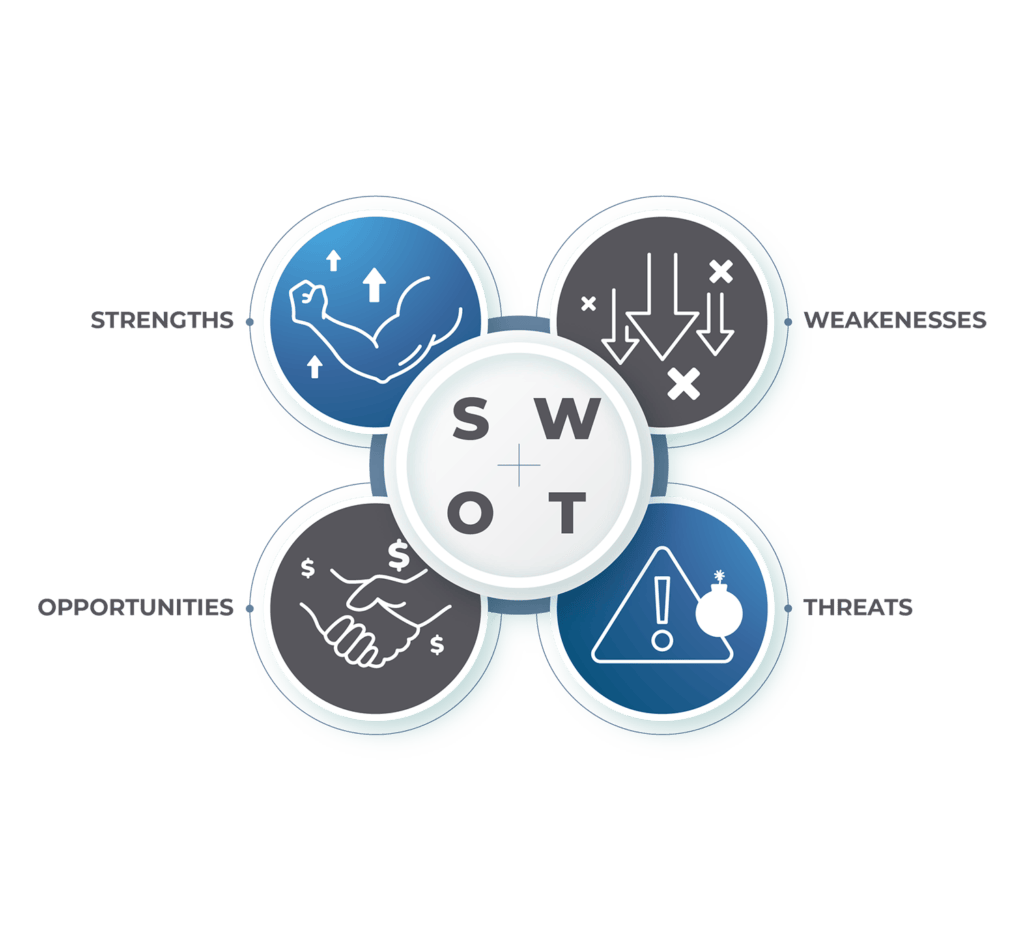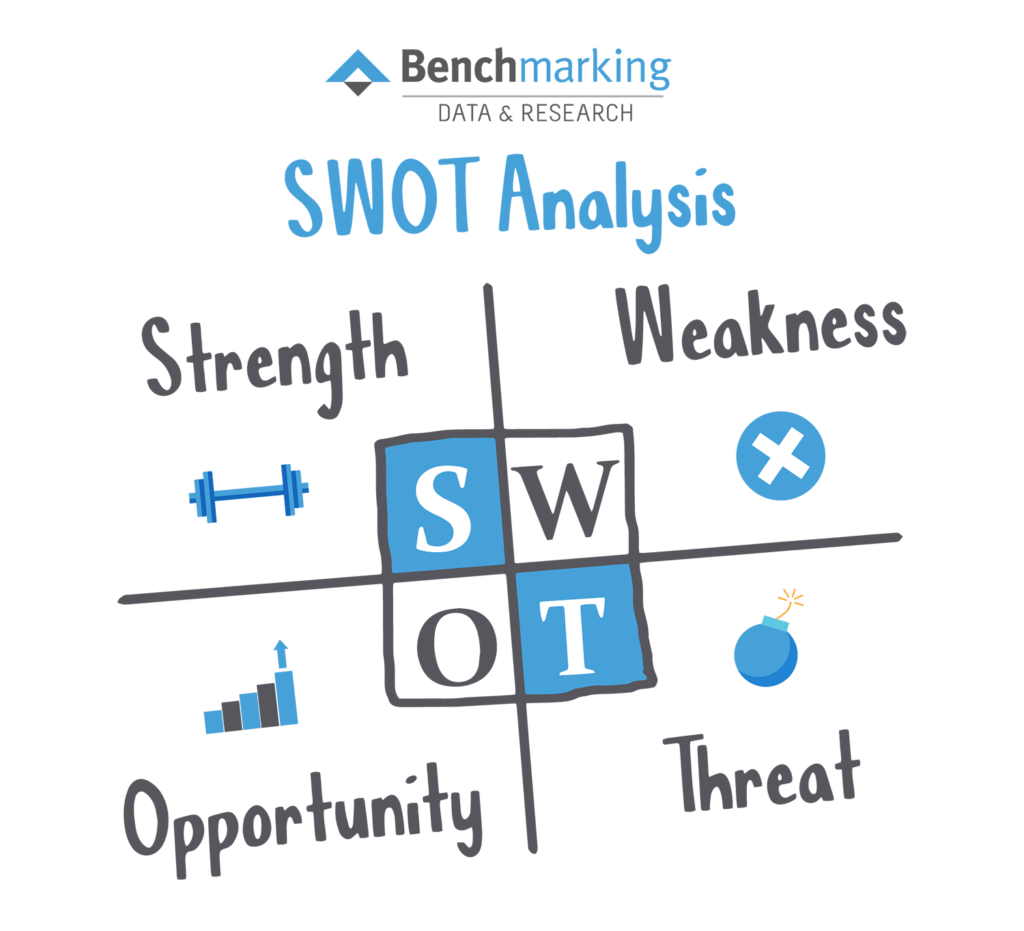
A SWOT Analysis is a strategic planning tool for businesses. It is designed to identify the strengths, weaknesses, opportunities, and threats facing a business. It lays the groundwork for informed decision-making, guiding companies in navigating their competitive landscapes.
This guide offers an overview of what a SWOT Analysis is, how to create one and where you can use it.
The article covers:
What is a SWOT Analysis?
SWOT Analysis is a strategic planning tool that stands for Strengths, Weaknesses, Opportunities, and Threats. It’s a comprehensive method used to evaluate the internal and external factors influencing a business’s performance and potential.

The SWOT Analysis can also offer a clear view of a company’s position within its industry. Understanding each component with detailed examples provides a deeper insight into how to effectively leverage this analysis.
Strengths: Internal Positive Attributes
Strengths are the unique advantages a business possesses, setting it apart from competitors. They are internal attributes that can be harnessed for growth and success.
Examples of Strengths
➤ Innovative Product or Service: For instance, a tech company that has developed a unique AI-driven tool that simplifies data analysis.
➤ Strong Brand Reputation: A fashion retailer known for its exceptional customer service and high-quality products.
➤ Robust Financial Health: A construction company with substantial cash reserves and low debt, allowing for flexible operations and investment.
➤ Advanced Technology Usage: A logistics company employing cutting-edge GPS and RFID technology for efficient tracking and management.
➤ Highly Skilled Workforce: A consultancy firm with a team of experts renowned in their respective fields.
Weaknesses: Internal Negative Attributes
Weaknesses are internal factors that can hinder a company’s performance and growth. Identifying these areas is crucial for improvement and risk mitigation.
Examples of Weaknesses
➤ Limited Marketing: A local bakery with fantastic products but lacking an online presence or advertising strategy.
➤ Outdated Technology: A retail store using old point-of-sale systems that slow down transactions.
➤ High Employee Turnover: A call center struggling with retaining staff, leading to increased training costs and inconsistent service quality.
➤ Supply Chain Inefficiencies: A manufacturing business experiencing frequent delays due to an unreliable supply chain.
➤ Inadequate Customer Service: A telecom company receiving regular complaints about its customer support.
Opportunities: External Factors for Growth
Opportunities are external conditions or trends that a business can capitalise on to drive growth and gain a competitive edge.
Examples of Opportunities
➤ Market Expansion: The rise in remote working opens opportunities for a furniture company to design home office setups.
➤ Technological Advancements: An accounting firm could adopt new software to offer more efficient and secure financial services.
➤ Changing Consumer Preferences: A growing interest in sustainability could benefit a company specialising in eco-friendly products.
➤ Strategic Partnerships: A small health food store could partner with local gyms to expand its customer base.
➤ New Market Needs: The COVID-19 pandemic highlighted opportunities for businesses in virtual event management and digital communication tools.
Threats: External Factors Posing Risks
Threats are external challenges or changes that could negatively impact a business. Recognising these threats is vital for developing defensive strategies.
Examples of Threats
➤ Increasing Competition: A new café opening nearby poses a threat to an existing coffee shop.
➤ Regulatory Changes: New environmental regulations may increase production costs for a manufacturing company.
➤ Economic Downturns: A recession can lead to reduced spending, affecting luxury product retailers.
➤ Technological Disruption: The rise of e-books poses a threat to traditional bookstores.
➤ Social Trends: A shift in consumer behaviour towards online shopping can threaten physical retail stores.
A thorough understanding of a business’s strengths, weaknesses, opportunities, and threats is therefore a core part of strategic planning. By identifying these components with clear examples, consultants and advisors can offer more targeted and effective guidance to their clients.
When Do You Use a SWOT Analysis?
A SWOT analysis is versatile and can be employed across different stages of business management for a variety of purposes. However, it’s important to determine WHAT you want the SWOT for before you begin. For example, a general SWOT on the business opportunities may be very different to analysing a marketing opportunity or assessing a team’s performance.
There are many areas you can use a SWOT Analysis for. This includes:
Strategic Planning: In strategic planning, SWOT analysis helps in setting achievable goals by identifying competitive advantages and areas for improvement. It guides the allocation of resources to enhance efficiency and achieve long-term objectives.
Problem-Solving: SWOT analysis offers a structured approach for tackling specific business challenges. It aids in identifying internal and external factors contributing to issues and devising sustainable solutions.
Team Analysis: A SWOT analysis can also be used to identify team strengths and areas for improvement. It aids in refining team skills and aligning them with business goals. Regular analysis can help keep teams agile and effective.
Decision Making: For evaluating new initiatives or considering strategic shifts, SWOT analysis assesses the potential impacts and supports informed decision-making by weighing strengths, weaknesses, opportunities, and threats.
Business Reviews: During periodic business reviews, SWOT analysis assists in evaluating performance and adjusting strategies to align with evolving internal capabilities and market conditions. It ensures ongoing agility and strategic relevance.
Employing SWOT analysis across these scenarios ensures that organisations not only capitalise on their internal strengths and external opportunities but also address vulnerabilities and mitigate risks effectively.
How Do You Conduct a SWOT Analysis?
Conducting a SWOT analysis is a streamlined process designed to uncover insights for strategic decision-making. Here’s how to approach it effectively:
- Define the Purpose
Before you begin, it’s important to define WHY you want to do a SWOT. Make sure the purpose is clear and everyone involved understands the situation you are analysing.
- Research & Collect Data
Next, kick off your SWOT analysis by gathering comprehensive data. Dive into market research, financial reports, customer feedback, and competitor analysis. This step lays the groundwork by providing a clear picture of your internal capabilities and the external environment.
- Engage Team and Stakeholders
Bring together team members and stakeholders from across the organisation. This inclusive approach ensures a variety of perspectives and expertise are considered, enriching the analysis with insights from different facets of the business.
- Identify What’s Important (and What’s Not!)
Sift through the collected data to pinpoint key strengths, weaknesses, opportunities, and threats. It’s crucial to distinguish between critical factors that can significantly impact the business and less relevant ones. This prioritisation helps focus efforts on areas that truly matter.
- Analyse and Strategise
With the key factors identified, analyse how they interact and affect your business. Use this analysis to formulate strategies that leverage strengths and opportunities, address weaknesses, and mitigate threats. This final step translates insights into actionable plans, setting the stage for strategic advancement.
You Have Completed Your SWOT Analysis – What’s Next?
Once you have completed your analysis – sum it up in one page! The most common way to present a SWOT Analysis is as follows:

This enables you to both easily share it with others and add it to other documents as you need.
A SWOT Analysis is usually part of a broader plan. Thus, once it’s completed, it can be used to support in completing other strategic plans and/or reviews.
To ensure you leverage the hard work in compiling your SWOT, you can implement the below actions:
➤ Combine It With Other Business Insights
Your SWOT analysis should not be looked at in isolation. It’s most effective when integrated with other business analyses, such as market research, financial reports, and operational reviews. This integration enriches your strategic perspective, ensuring decisions are informed by a comprehensive understanding of your business environment and internal capabilities.
➤ Develop a Practical Action Plan
Leveraging the insights from your SWOT analysis, it’s time to draft a practical action plan. This involves setting clear, actionable goals based on your identified strengths, weaknesses, opportunities, and threats. Specify tasks, assign responsibilities, and set deadlines. The goal is to transform strategic insights into tangible actions.
➤ Implement and Monitor
With your action plan in hand, the next step is implementation. This stage is about bringing your plan to life, mobilising resources, and guiding your team towards achieving the set objectives. Monitoring progress is equally important, allowing you to track performance against goals and make necessary adjustments.
➤ Regular Review and Adaptation
The business landscape is constantly evolving, making it essential to regularly revisit and update your SWOT analysis and action plan. This ongoing review process ensures your strategies remain relevant and responsive to new challenges and opportunities that arise.
Remember, a SWOT analysis is a starting point for strategic planning. It offers valuable insights but gains true utility when combined with other business planning tools, translated into an actionable plan, and continually adapted to the changing business environment. This approach ensures that your strategic planning is dynamic, relevant, and effective in achieving your business goals.
You can use our Business Benchmark Report to help build your SWOT Analysis!
